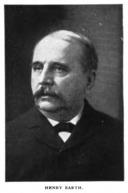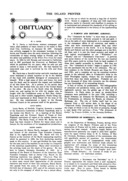Henry Barth [born Hans Barth]. 1823-11-27 - 1907-01-30.
Barth is best remembered as the co-designer (with Ernst Lietze) of the Barth Type Caster, though considerable mythology now attends this development.
The primary source for our information on Barth is an article by William E. Loy in 1901 [1]. This was a part of Loy's series of articles for The Inland Printer on "Typefounders and Typefounding in America." Loy tells us that Barth was was born "in Leipsic, November 27, 1823." Leipzig was at that time a part of the Kingdom of Saxony. Of his training and early work, Loy says that he "was apprenticed as a mathematical instrument maker" and that he constructed Bruce (pivotal) style type casters in the typefounding department of the publishing firm of Brockhaus (in Leipzig).
The period which saw Barth's emigration to the United States was an unsettled one in Europe. Loy says that Barth "served two years as an engineer in the German navy, during the war with Denmark." The war with Denmark must have been the First Schleswig War (1848-1851). This was a complex war involving on the one side the Kingdom of Denmark (with assistance from Austria and Russia) and on the other side Prussia and the German Confederation (the Kingdom of Saxony was a member of the latter). It is interesting that Loy says that Barth served as an engineer in a navy. At the outbreak of the First Schleswig War in 1848, the German Confederation had no real navy (many of its states, such as Barth's own Kingdom of Saxony, were landlocked). But two months after the outbreak of this war, the Frankfurt Assembly (a part of the Revolutions of 1848) in the German Confederation authorized the creation of the Riechsflotte. This (small) navy existed until 1852.
The First Schleswig War lasted until 1851, but Loy tells us that Barth emigrated in 1849. That date is interesting, because it is the year following the crushing of the European-wide Revolutions of 1848 by reactionary forces. The failure of the revolutions led to the emigration of a significant number of well-educated liberal technologists to the United States. Many of these settled in the midwest, notably in Milwaukee and Cincinnati. (The Wikipedia article on The Forty-Eighters notes that "More than 30,000 Forty-Eighters settled in what became called the Over-the-Rhine neighborhood of Cincinnati.") So it is likely (although not yet certain) that Barth's emigration had more to do with the failed revolutions of 1848 than the First Schleswig War. Barth would have been about 26 years old at the time.
Soon after emigrating to America in 1849, he began work at the Cincinnati Type Foundry, and began a long series of printing and typefounding developments. Loy says that at his start there he was "foreman, draughtsman and constructor combined." Barth became part owner of the foundry during the US Civil War (when the foundry survived by casting bullets and making Gatling guns [2]). At least as early as the 1870 Cincinnati Type Foundry Specimen and Price List [3] he is listed as "President."
He was a founding member of the West End Turnverein, a Turner Society [4]. The association of Turner Societies with the liberal Revolutions of 1848 further suggests that Barth left Saxony for political reasons.
Upon the amalgamation of the Cincinnati foundry into American Type Founders at its creation in 1892, Barth became a member of the board of ATF. (But by at least 1902, he was no longer manager of the Cincinnati branch (a position held by H. S. Kibbe), but was instead merely the manager of its foundry [5].
Barth's obituary in The Inland Printer raises a question as to his status at ATF at the time of his death. Earlier ATF literature indicated that Barth was the manager of the foundry at Cincinnati, but not of the branch itself. But in the 1902-1906 timeframe all manufacturing operations were consolidated into a single plant. The Inland Printer obituary identifies him as "manager of the Cincinnati branch of the American Type Founders Company." [6].

Loy (1901)
Loy, William E. "Typefounders and Typefounding in America: No. 15, Henry Barth." The Inland Printer, Vol. 28, No. 2 (November, 1901): 244-245.
The icon here links directly to the PDF of this article in the reprint of Loy's "Typefounders and Typefounding in America" within the Notebook on General Literature on Making Printing Matrices and Types.
In addition to the biographical information on Barth, this article is significant because it provides evidence of two small but important points in the history of typefounding. First, it confirms that the Cincinnati foundry was Foundry D. Second, it confirms that by this date all of the casters (including therefore the Barths) at the Cincinnati foundry were electrically driven.

Inland Printer (Obituary, 1907)
"Henry Barth" [obituary]. The Inland Printer. Vol. 39, No. 1 (April 1907): 90.
The icon at left links to a PDF version of the single page containing Barth's obituary.
This obituary is incorrect in saying that the Barth caster was "the machine used to-day in a majority of the American typefoundries." It was used in only one type foundry in 1907: ATF. While ATF was the largest foundry, it was only one of several (and thus certainly not "the majority").
The photograph below appeared in the 1902 ATF volume American Type Founders Co.: Its Business and Resources Illustrated, where Barth was shown only as the "Manager Cincinnati Foundry" (while Benton got his photograph in the frontispiece). ( {ATF Illustrated 1902}, p. 39)
This photograph illustrated the 1901 article on Barth which appeared as No. 15 in the series "Typefounders and Typefounding in America" by William E. Loy ( see above).
The photograph below appears through the courtesy of Richard L. Hopkins (Hill and Dale Private Typefoundry and Press). It is the same photograph which appeared in "Discursions of a Retired Printer, No. 7" by Henry Lewis Bullen (writing under the pseudonym of "Quadrat") in The Inland Printer, Vol. 38, No. 4 (January, 1907): 513-521. See the CircuitousRoot Notebook on Henry Lewis Bullen for a reprint of this article.
1. {Loy 1901}.
2. See Loy and also {Keller 2008}.
4. {Woellert 2012}, p. 122.
5. {ATF Illustrated 1902}, p. 39.
6. {IP 1907}.
{ATF Illustrated 1902} American Type Founders Company. American Type Founders Company: Its Business and Resources Illustrated. [no location, but the ATF General Offices were in New York City at this point]: American Type Founders Company, 1902.
This has been scanned by Richard L. Hopkins from the Skyline Type Foundry copy and is online in the CircuitousRoot Notebook on American Type Founders
{Cincinnati 1870} The Cincinnati Type Foundry Co's Specimen and Price List. (Cincinnati, OH: Cincinnati Type Foundry Co., 1870.)
This has been digitized by Google Books from the NY Public Library copy. See the Cincinnati Type Foundry Notebook for a reprint.
{Keller 2008} Keller, Julia. Mr. Gatling's Terrible Marvel: The Gun that Changed Everything and the Misunderstood Genius Who Invented It. NY: Penguin 2008.
{Loy 1901} Loy, William E. "Typefounders and Typefounding in America: No. 15, Henry Barth." The Inland Printer, Vol. 28, No. 2 (November, 1901): 244-245.
{Woellert 2012} Woellert, Dann. Cincinnati Turner Societies: The Cradle of an American Movement. The History Press, 2012.
All portions of this document not noted otherwise are Copyright © 2015 by David M. MacMillan and Rollande Krandall.
Circuitous Root is a Registered Trademark of David M. MacMillan and Rollande Krandall.
This work is licensed under the Creative Commons "Attribution - ShareAlike" license. See http://creativecommons.org/licenses/by-sa/3.0/ for its terms.
Presented originally by Circuitous Root®
Select Resolution: 0 [other resolutions temporarily disabled due to lack of disk space]